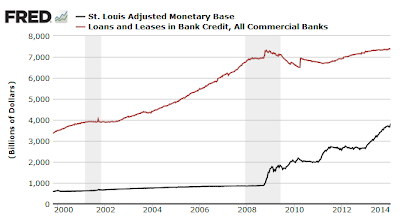In Reflections on the Yellen Taper-Hike Announcement; What Does the Fed Know? I quoted the opinion of Saxo Bank Chief economist Steen Jakobsen.
Steen commented “Please, do not think for one minute that FOMC have any clue about the economy six months from and even less so looking into 2015.“
I am certainly in agreement with Steen, and gave my own look into what the Fed knew or didn’t in Hilarious Transcripts of Fed Minutes from 2008 Reveal Completely Clueless Fed.
Opinions aside, let’s take a look at facts from a monetary point of view.
My friend “BC” pinged me with the following chart.
Monetary Base vs. Loans and Leases

click on any chart for sharper image
Note that the adjusted monetary base is playing catchup to loans and leases of all commercial banks.
When that happens, and I believe it will, taper or no taper, will base money be sufficient to cover all credit?
Not quite. Taking a lead from “BC”, here is a chart I put together.
Credit Market Instruments Liability vs. Monetary Base
This is precisely what fractional reserve lending has wrought. Total credit liabilities approach $60 trillion. Those liabilities are backed up by about $4 trillion in base money supply.
Some people might object the above chart reflects money substitutes and not money. Fair enough. So how much base money covers checking and savings accounts?
Monetary Base vs. Checking Plus Savings Accounts
Some readers will recognize the above chart as True Money Supply “TMS2” vs. Base Money Supply.
TMS2 consists of currency plus all the individual components of checking and savings deposits.
In terms of how much base money covers savings and checking accounts, you can see about $6 trillion is missing. Loans and Leases are another matter as is Total Credit Liability.
So when the Fed says it will “taper”, let me ask some simple questions:
- In what timeframe?
- For how long before the next monetary expansion happens?
- What happens in the event of a recession or even a serious global slowdown?
- What will other central banks do?
Bonus Question: What is this likely to mean for gold?
Mike “Mish” Shedlock
http://globaleconomicanalysis.blogspot.com

